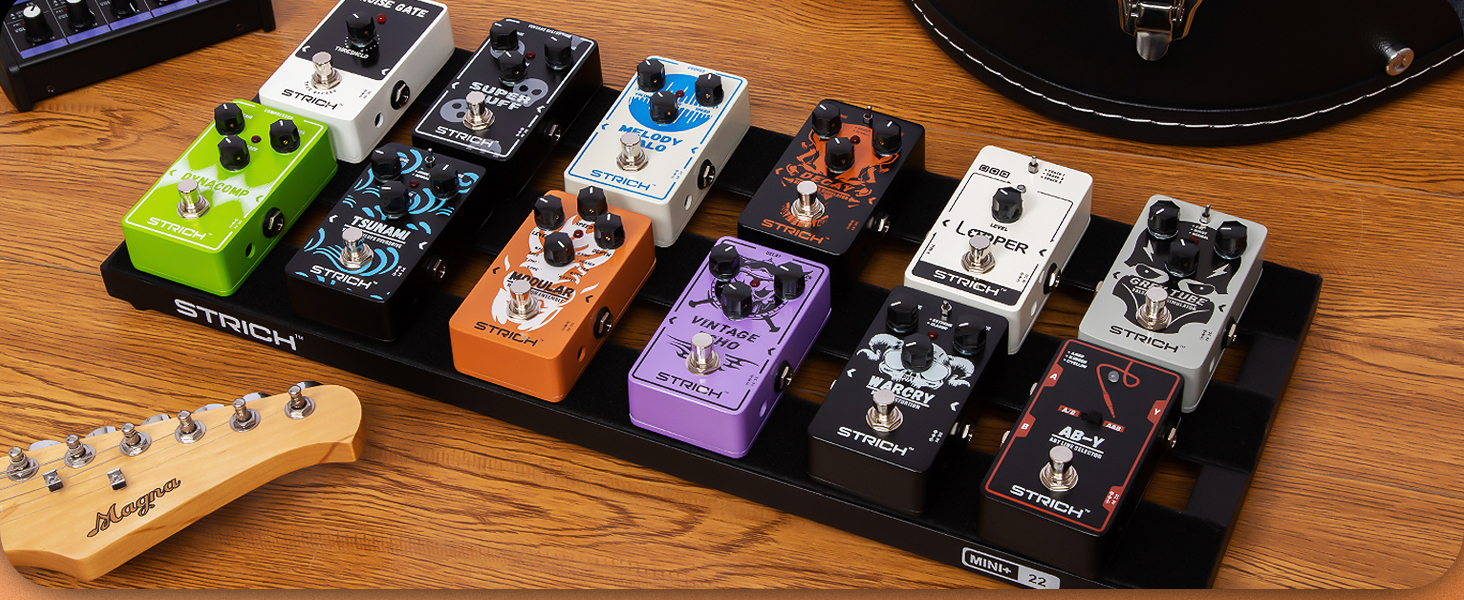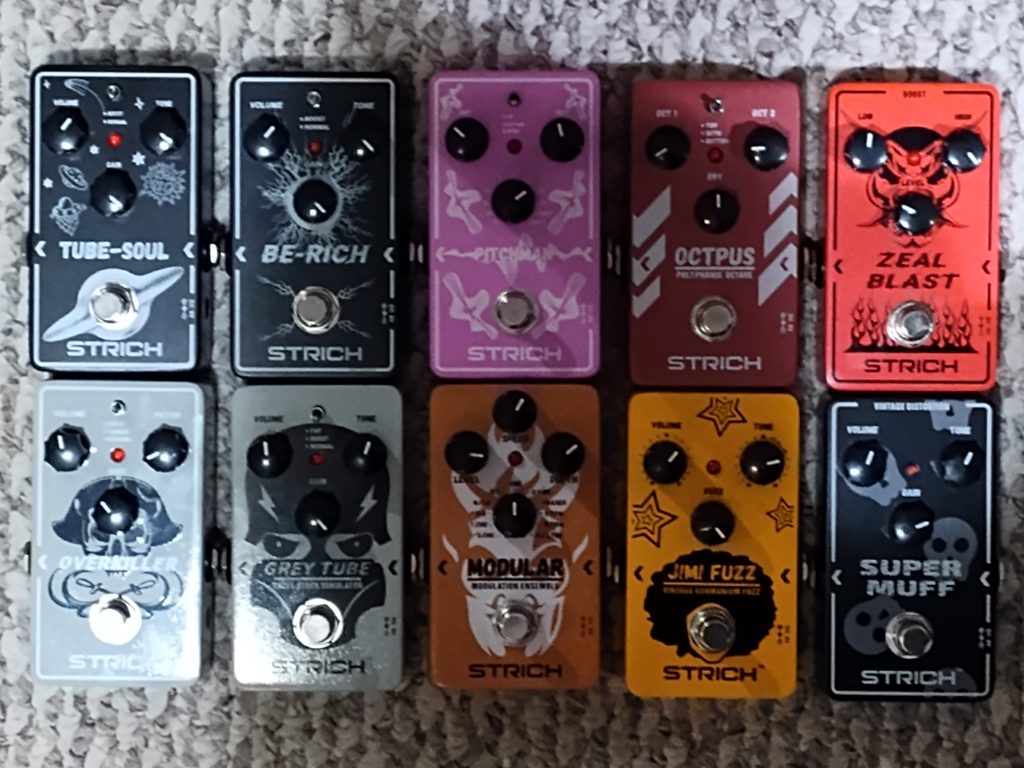
Budget-conscious tone seekers who regularly comb Amazon or Temu for good, affordable guitar pedals have undoubtedly encountered Strich. The company offers a wide assortment of attractive full-sized pedals housed in colorful metal casings and decorated with often ominous designs. Almost every pedal has three knobs arranged in a triangle and a red on/off light between the left and right knobs. Many also have a two or three-way switch that offers slightly different tone profiles. And while Strich pedals are sturdy with sizable, easily adjustable controls and a true bypass footswitch, and perform admirably well, they’re some of the least expensive, generally hovering somewhere between $25 and $50.
If you’re in the market for a delay, flangers, reverb, pitch shifter, or looper, Strich has products worth perusing, but the company’s specialty is dirt, and there’s no shortage of it. They have piles of overdrives, distortions, and fuzz pedals in various configurations, catering to a broad clientele, including blues benders, stoner rock riffers, punk bashers, alternative players, and death metal grinders.
Many of Strich’s pedals are modeled after or directly clone established pedals, new and old. They do an admirable job, considering the pedals are created in bulk in factories and aren’t meant to vastly improve upon the specs of the original. If that’s your jam there are some great boutique pedal manufacturers out there that can give you exactly what you need. But if you’re not insanely picky and are mostly looking to mix up your sound a bit at home, in jam sessions, or at live gigs, Strich’s pedals are well worth considering. It’s especially satisfying to find one that replicates an out-of-print vintage pedal, which would cost a small fortune to add to your collection.
To make the search through the Stritch catalog a little easier, we’ve reviewed 10 of their most popular pedals and pointed out lots of the highlights and a few shortcomings. We originally planned to review them in order from worst to best, but since the desirability of a pedal is largely dependent on what kind of music you play, what you already own, and what specific features tweak your knobs, we decided to write about the pedals in no particular order.
BE- RICH
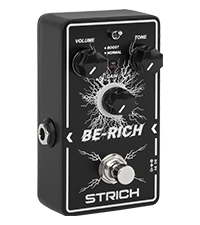
Judging by how many Strich pedals are aimed at metal fans, we thought the Be-Rich pedal would deliver the biting, high-gain tones of BC Rich guitars. The black casing, fractured title font and image of a fireball made of lightning threw us off. But that’s okay, the pedal is a no-frills overdrive designed to emulate the Ibanez Tune Screamer. The sound is, indeed, rich, and the pedal can flip between normal and boost mode. When dimed, the dirt is thick enough for rock and the overdrive borders on distortion, but is delivered through warm, smooth midrange frequencies. However you choose to set it, the distortion never overwhelms the guitar tone, ensuring the sound of the fretted strings are front and center. Whether playing dense power chords, complex jazz chords, or breaking into a solo. On that, err, note, when digging into a lead, don’t forget the boost switch, which fattens whatever you’re playing. The Strich Be-Rich is an overdrive pedal designed to emulate the iconic Ibanez Tube Screamer, a classic choice for blues and rock guitarists. This budget-friendly option aims to capture that signature Tube Screamer sound – a warm, smooth overdrive with a focus on midrange frequencies.
TUBE-SOUL
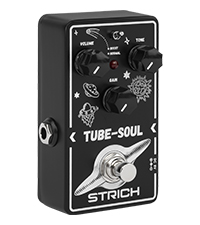
Unless you’re fanatical about the many varieties of Tube Screamer sounds that are out there, you might not need the Be-Rich and the Tube-Soul. The former is more of a direct Tube Screamer clone, while the latter more closely resembles the Ibanez TS9, which is capable of a warmer, smoother tone than the Tube Screamer. That said, depending on how you like your screaming, you might find the tones of one more ear-pleasing than the other. Both pedals are black, but while the Be-Rich strives for an electric lightning storm look, the Tube-Soul taps into a galactic vibe, with a large Saturn over the foot switch, and a spaceship, other planets, and a shooting star decorating other parts of the pedal. Otherwise, the controls are identical: three knobs and a two-way toggle switch featuring “normal” and “boost” modes. Don’t be fooled by the name, the pedal doesn’t cry out with “soul” and the sound isn’t reminiscent of a tube amp.
OVERKILLER
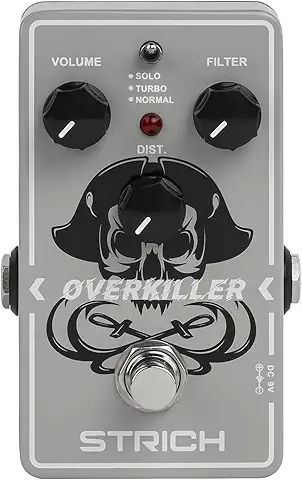
Colored gray and decorated with a skull wearing a pirate’s hat, the Overkiller is easier to immediately grasp than the cryptic Be-Rich. Featuring high-gain circuits, the pedal is capable of a range of biting tones somewhere between the Fulltone OCD and the ProCo Rat, with a bit of Boss Metal Zone sprinkled in. The filter knob is the key to shaping your sound, and, strangely, it gets more aggro the more counterclockwise it’s turned. At the lowest gain setting, the sound remains strong and performs well with lightly distorted rock. Those seeking a hornet nest buzz with strong sustain will likely prefer the higher gain settings and scooped filter tones. At the same time, a bit of knob-twisting experimentation, and the Overkiller offers powerful midrange and a tight low-end that suits metal, punk, hardcore, and noise rock.
GREY TUBE VALVE STACK SIMULATOR
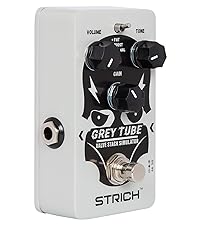
With the Grey Tube Valve Stack Simulator, Strich captures the sound of a classic valve tube amplifier. The gray pedal is decorated with a dude wearing a gas mask and can be adjusted to various tones and distortion levels with the “Tone” and “Gain” knob and the three-way toggle switch, which offers “normal,” “boost,” and “fat” settings. Like many gain pedals, it most closely approximates the sound of the Marshall Plexi. The “gain” knob provides a range of distortion sounds that are thick and saturated, with a focus on midrange and tight low-end. Even at its highest gain settings, the pedal lacks the fizziness of the Strich Holy War or the Rowin Metal pedal, both of which are modeled after the Boss Metal Zone. On its lower settings, the Grey Tube produces a smooth overdrive sound, and when cranked it’s capable of crunchy, heavy distortion. Maybe it’s not as mean as Overkiller, but it features a more diverse range of settings.
PITCHMAN
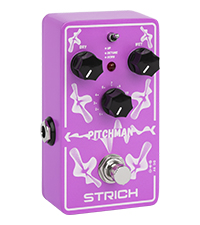
Modeled after the Pitch Fork polyphonic pitch shifter by Electro-Harmonix, The Pitchman delivers a thick, layered sound, creating two tones at once, depending on how it is set. The middle dial has multiple settings that determine the secondary tone that will play over the root note. There are 11 settings, ranging from 1 to 7, 9 to 11, and then settings for one and two octaves. There’s an additional knob that determines the setting for the dry signal and another for the wet signal. And there’s a three-way toggle switch that determines with the second tone will play below the original note, above the original note or slightly out of tune with the original note. The most useful settings for most players are thirds (enabling tritone harmonies), fifths (creating a power chord or traditional harmonies), sevenths (also great for harmonies), and the one and two-octave (which can create earth-shaking doom metal tones when paired with distortion or fuzz in the down position. The Pitchman can also emulate a bass guitar when in the single-octave setting with the wet knob cranked and the dry signal turned all the way down. For a $50 pedal, the tracking accuracy of the Pitchman is impressive. The purplish-pink housing is decorated with what seem to be budding flowers, but at least the knobs are sturdy and there are an abundance of sounds to explore.
OCTPUS

Here’s a case where Strich may have stepped on its own toes – or in this case, tentacles. The Octpus is a polyphonic octave pedal modeled after the Electro-Harmonix Micro Synth. It features exclusively octave-up and octave-down signals, each controlled with its own knob. The third knob on the effect controls the wet and dry concentration of the signal. The Octpus is a little too similar to the Pitchman, so most players likely won’t need both. But those who want to operate strictly in polyphonic octaves might find it more to their liking than the Pitchman. The pedal works well with various dirt effects and allows players trigger single and double octave settings at the same time (up, down, or both), creating thick, layers of multi-tones that can sound subtle or absolutely sick. The three-way toggle switch controls whether the wet signal pitches upwards, downwards or both at the same time. The box is an attractive crimson color and decorated with minimalistic angled lines.
ZEAL BLAST
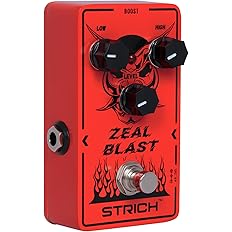
Here’s another example of Strich keeping consumers guessing. Housed in a red casing and featuring a fragmented font and images of a demonic creature and a wall of flames, it would be reasonable to assume the Zeal Blast is a high-gain metal pedal. It’s not. The Zeal Blast is a boost pedal with some interesting features. The three settings knobs are “low,” “high” and “level,” and can be used together to boost a player’s sound and intensity during a solo. But that’s not all the Zeal Blast can do. It can easily be stacked with an overdrive, distortion, or fuzz pedal, and due to the tone sculpting configurations, there are also various cool setting options with a clean tone. When the level is dimed the amp sound will start to break up and distort like old tube amps played at maximum volume. And when the level is at one o’clock or lower and the low and high knobs are tweaked, the pedal provides a clean boost with strong sustain that makes us think of a compressor. The Zeal Blast is an interesting, very usable effect that creates a different palate of sound than its name suggests.
MODULAR MODULATION ENSEMBLE
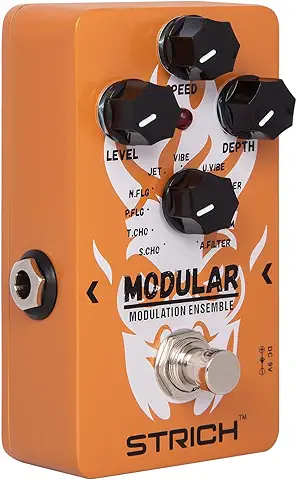
Pedals like the Modeler Modulation Ensemble are great when you want to add a specific effect to a song you’re playing that you don’t the need to use on a normal basis, and you don’t want to shell out the cash or don’t have the space for individual modulation pedals. The Modulation ensemble packs seven types of effects (two chorus settings, two tremolo settings, three flanger settings, vibe, univibe, phaser, and filter) onto a single pedal. The only drawback is you can’t play more than one at a time, and to get an optimal tone, you’ll likely need to tweak the level, speed, and depth knobs, making it impractical to use for more than one song in a gig. But heck, this thing is mega-fun to play with and gives users a great taste of specific effects – in case they want to invest in more fully realized versions of their favorites later. That said, we’ve gotten some crazy-cool sounds out of this pedal, whatever setting we’ve dabbled with. We’re especially fond of the flangers, tremolos, and vibes, but stack some of these sounds up with other pedals, and in no time you’ll discover you’re favorites as well.
JIMI FUZZ
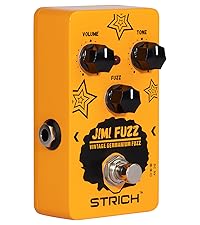
Clearly striving to capitalize on the organic, fuzzy, guitar flurries of Jimi Hendrix, the Jimi Fuzz is orange and features a giant afro around the pedal switch. The rest of the effect is decorated with stars. ‘Scuse us while we kiss the sky. Hendrix played a variety of fuzz pedals, including the Dallas-Arbiter Fuzz Face, the Axis Fuzz and a homemade gray pedal, and he favored a combination of germanium and silicon transistors to give him a broad range of tones. The Jimi Fuzz is fueled by germanium circuits and is reminiscent of a Fuzz Face. And, sure, it’s capable of generating sounds redolent of Hendrix. But it also excels at grittier, buzzier tones better suited for psychedelic garage rock, grunge, doom, and stoner metal. Play around with the “Tone” and “Fuzz” settings to discover what works for you. The fuzz knob is especially impressive. At noon it delivers a dense, smooth buzz, but crank it all the way up and you’ll get a wonderfully volatile sound that sounds like a ProCo Rat on the way to self-destruction. And while every note can be heard – unlike on some Velcro fuzz tones – the sound is just shy of bursting into flames.
SUPER MUFF
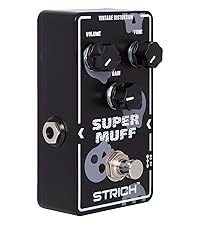
Compared to the Jimi Fuzz, the Super Muff is far more restrained. It was designed after the Electro-Harmonix Big Muff Pi, but it doesn’t hit condition critical until the “fuzz” setting is at 3 o’clock or so. In its more extreme settings, the pedal is thick and saturated, with plenty of sustain. The Super Muff will deliver sounds that the Jimi Fuzz doesn’t quite reach, and it sounds great when playing Black Sabbath-style metal or velvety distorted grunge. That being the case, for our money, the Jimi Fuzz delivers more tonal variation and exciting unpredictability.

